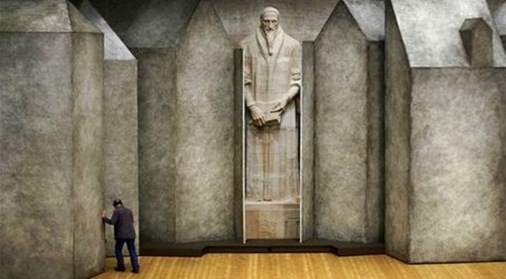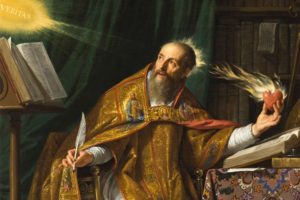A pastor recently wrote me inquiring into reasons for the “so many people” who appear to be moving toward the Roman Catholic Church. He suggested that what Collin Hansen called the Young, Restless, Reformed: A Journalists Journey with the New Calvinism, in his landmark book, now also appears to be the “Young, Restless, and Roman.” How can this be?
It is helpful to consider that before Collin told the story of neo Calvinism, a similar kind of renewal movement rose to prominence. The so called Oxford Movement of nineteenth century England (also called the Tractarian Movement) was “similar” in the sense that several young, theologically minded, energetic individuals employed the resources of books, tracts, sermons, news media and theological conferences to challenge existing religious structures in favor of reform. Of course, the basis and aims were quite different: Anglo-Catholicism as opposed to Reformed theology. But on the level of method, it was more alike than is often realized.
When men such as John Henry Newman (1801-1890) and his colleagues from Oriel College reclaimed a part of Christian tradition (i.e., the Church Fathers of the Fourth Century) in the service of a pastorally dynamic and theologically robust faith, they were young and restless. In the case of Newman, he was so restless that he not only moved away from his Calvinist background; he eventually moved through High-Church Anglicanism into the full embrace of Roman Catholicism. In what follows, we will briefly consider the contours of his movement with a view to learning lessons that serve us in conversation among friends who are considering conversion to Catholicism today.
Newman: A Man on the Move
Newman’s conversion to Roman Catholicism in 1845, like all spiritual conversions, consisted of a “push” and a “pull.” A certain discontent with Anglicanism, which effectively pushed him into the Tiber River, and a thirst for what Catholicism had to offer, which pulled him to the other side. To be sure, he faced obstacles along the way, but none so great as to deter his progress. Following is an overview of these movements: a major push, a pull, and a formidable deterrent which he overcame. Such lessons provide insight into the reasons why men and women are drawn to the Catholic Church.
Push
Growing out of his study of the Post Nicene Fathers, Newman grew uncertain about whether Anglicanism could be properly called “Catholic.” Was it truly universal? These doubts took root in 1839, when he read an article by Cardinal Nicholas Wiseman in the Dublin Review in which Anglicans were compared to African Donatists during the time of Augustine—a splinter group that was more parochial than catholic. Reflecting on this question over time, Newman began to correlate the Church of England with the heretical Arians of the fourth century. In Newman’s mind, Anglicanism failed the Catholic test.
Pull
There were several features of Catholicism that attracted Newman: the objective character of sacramental rites, a rich and textured liturgy, clerical celibacy—a discipline to which he had committed himself at a young age, and an authoritative magisterium that transcended British borders. Most of all, perhaps, Newman was attracted to the Catholicity of the Mass.
When he was on his Mediterranean tour in 1832-33, Newman visited Catholic churches in Malta and on the Italian peninsula. Describing this experience, he writes the following:
[W]hen I was abroad, the sight of so many great places, venerable shrines, and noble churches, much impressed my imagination. And my heart was touched. Making an expedition on foot across some wild country in Sicily, at six in the morning, I came upon a small church; I heard voices, and I looked in. It was crowded, and the congregation was singing. Of course it was the mass, though I did not know it at the time. And, in my wary days at Palermo [during my illness], I was not ungrateful for the comfort which I had received in frequenting the churches; nor did I ever forget it….[1]
This is how conversion works. What is at first unfamiliar and off-putting grows on us, and eventually it becomes a value with magnetic force. Such was Newman’s relationship to Catholic liturgy. Writing to an Anglican friend, for example, after his conversion, Newman says:
[I am writing beside the chapel]—It is such an incomprehensible blessing to have Christ in bodily presence in one’s house, within one’s walls, as swallows up all other privileges… To know that [Jesus] is close by—to be able again and again through the day to go in to Him…[2]
An Obstacle
A part of Catholicism that deeply troubled Newman was its sub-biblical “superstition,” religious accretions such as papal primacy, devotion to the Blessed Virgin and the saints, veneration of relics, Purgatory, monastic vows, and the like. For instance, he writes the following impression of the Catholic Church during his visit to Italy as an Anglican:
Oh that thy creed were sound!
For thou dost soothe the heart, Thou Church of Rome
By thy unwearied watch and varied round
Of service, in thy Saviour’s holy name
I read that line when I was visiting the Vatican last year, and resonated with it. There was so much beauty and meaning surrounding me, if only I could agree with Catholic theology. Well Newman found a way. In his Essay on the Development of Doctrine, which he wrote in 1845, Newman addressed his doubt by reasoning that external religious traditions grow into shape over time, like an acorn that develops into a tree. Similar to Charles Darwin’s work, On the Origin of Species, Newman postulated his theory as an explanation of how a subject might progressively evolve from one state to another. This enabled him to embrace the external elements of Catholic tradition which lacked clear witness in biblical and church history.
So what is the bottom line behind Newman’s conversion? If we were to boil down the motivational factors surrounding his decision, attraction to the sacramental institution would be at the center. He jettisoned his via media for a via Romana and found a religious tradition that more convincingly laid claim to the universal scope of Christ’s sacramental presence.
Here are some principles that we learn from Newman’s conversion to Rome:
· Conversion usually consists of many twists and turns. As pilgrims on a journey, we often walk through different seasons of belief before landing on a particular position.
· Conversion is deeply personal. This is true on a vertical plane, since we make discoveries before the face of a personal God. It also happens horizontally, developing our thoughts among mentors and friends.
· The entrance point for evangelical Protestants is usually the issue of justification. For Catholics it is the question of how one identifies with the church.
· The destination of one’s conversion is largely connected to the place where he locates apostolic authority. If one recognizes the supreme form of this infallible deposit (on earth) to be in the institution of the church, he will be a Catholic. The one who finds it in the text of Scripture is a Protestant.
· Conversion carries a cost. To the extent that we anchor our conviction in the Catholic or evangelical Protestant traditions, we will inevitably alienate ourselves from certain individuals and communities.
In short, conversions of faith are embedded in concrete experiences that are deeply personal, with a definite push and pull, and obstacles along the way. These obstacles are challenges that either keep us contained or catapult us out of a belief system. When a religious position has the power to withstand objections and scrutiny, it undergirds faith as a foundation. On the other hand, when that formulation crumbles in the face of questioning, it becomes a doorway.
Under God’s sovereign hand, the direction toward which the young and restless move—whether they become Roman or Reformed—is influenced to a large extent by the above-mentioned factors. The greatest take away from this reflection, I believe, is the opportunity for evangelical Protestants to embody and proclaim redemptive grace with warm-hearted integrity. More than anything, this witness will direct restless hearts into the gospel of peace to realize true rest.
[1] The Letters and Diaries of John Henry Newman, ed. Charles Stephen Dessain et al. (London: Nelson, 1961-72; Oxford: Clarendon Press, 1973—) xi, 131.
[2] Ibid., 129.





